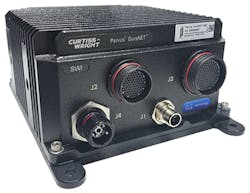Bringing the Advantages of PoE to Defense Applications
Power over Ethernet (PoE) devices can transmit and receive Ethernet data and electric power over the same network cable. Although, PoE has been around for almost two decades, for many military and aerospace applications, rugged deployable PoE solutions have only recently become available.
With Ethernet now the de facto backbone for mission situational awareness and network-centric operations in the military and aerospace applications, reliable MIL-STD qualified PoE-compatible devices can help system integrators reduce their platform SWaP and cost, while simplifying cabling, power, and device management for modern networked electronic payloads.
A Brief History of PoE
In the beginning, PoE was called “power injection.” It referred to power sourcing equipment (PSE), such as a network switch that could provide dc current to a powered device (PD), utilizing the unused twisted pairs in traditional Cat 5 copper Ethernet cabling that weren’t being used for 10Base-T or 100Base-TX operation.
In its early days, there were few standards or safety considerations, which meant that the use of power injection could unintentionally damage a device, especially one that wasn’t designed to accept power. To address the standardization of PoE, the IEEE 802.3 Working Group, the body that defines standards for Ethernet technology, got involved in 1999.
By 2003, the IEEE 802.3 Working Group had ratified the first standard, called IEEE 802.3af for “Type 1” PoE devices. Under this standard, power is transported on the same wire pairs, or spare wire pairs, as is the data for 10- and 100-Mb/s Ethernet variants. For Gigabit Ethernet (GbE) and faster, all four twisted pairs of the Ethernet cable are used for data, but just two pairs for power transmission. Power is transmitted on the data conductors by applying a common voltage to each pair. Because twisted-pair Ethernet uses differential signaling, this doesn’t interfere with data transmission.
The original PoE standard allowed for PSE to source up to 15.4 W and deliver up to 12.95 W per port to PDs. PoE switches or routers that provided power over the Ethernet cable were dubbed “endspan” or “endpoint” devices. External power injectors, called “mid-span injectors,” were to be used in combination with a non-PoE switch.
While 12.95 W may not seem like a lot of power, it was sufficient for many popular PDs, including voice over IP (VoIP) phones, stationary cameras, and door access control units, among others. However, it wasn’t long before some industries demanded even more power per port via PoE.
The IEEE 802.3 Working Group responded, and in 2009 adopted a new standard that nearly doubled the available power output. The IEEE 802.3a standard for “Type 2” devices, called PoE-Plus or PoE+, allowed PDs to source up to 30 W and deliver at least 25.5 W per port. This enabled expanded device usage with wireless access points (WAPs) and motorized security cameras with pan-tilt-zoom (PTZ) capabilities.
Not surprisingly, it wasn’t long before even more PoE power was desired in order to support to even more applications. It took a decade, but in 2018, the new IEEE 802.3bt standard, known as “4-Pair Power Over Ethernet” or “4PPoE,” was rolled out to support Type 3 (60 W) and Type 4 (90 W) devices for applications such as industrial lighting, door access systems, video phones, and thin-client computers.
The latest standard uses all four twisted pairs of an Ethernet cable to transmit power for GbE or faster. Each twisted pair needs to handle a current of up to 600 mA (Type 3) or 960 mA (Type 4). Support for 2.5GBase-T, 5GBase-T and 10GBase-T was also included. Looking forward, this standard may open new opportunities for devices that require 100 W for digital signage displays, point-of-sale systems, LCD TVs, smart homes, or other applications.
The Benefits of PoE in Aerospace and Defense
For designers of deployed aerospace and military systems vehicles, size, weight, and power (SWaP) is always at a premium. The use of smaller and lighter equipment allows more electronics payloads to be integrated onto a platform, and employing SWaP-optimized subsystems enables platforms to be more energy-efficient as well as go farther and/or faster.
While this is true for virtually all vehicles, it’s especially true for unmanned air, surface, ground, and undersea drones, for which every additional ounce can potentially limit mission distance or duration. Minimizing SWaP results in extended mission endurance as well as reduced fuel, battery, and operational costs.
With PoE, IP phones, cameras and other devices can be networked together while the platform’s cabling and power architecture can be simplified to help reduce SWaP. PoE eliminates the need for separate power supplies and cabling for each end device. It can also provide some additional device-management capabilities, since device power can now be remotely monitored and controlled over the network.
System management and troubleshooting are eased because PoE is able to provide a detailed electronic record of power usage and failures over the network. For example, if a device is intermittently drawing too much power, PoE lets the system shut that device down while recording which device caused the issue and what was happening on the network at that time. In turn, troubleshooting the system becomes easier and faster.
PoE can also reduce wiring costs, since the same traditional Cat 5/5E/6 cabling that may already be installed for network use can now also be utilized to power IP endpoint devices, reducing the cost of infrastructure or installation labor.
Rugged PoE Device
An example of a rugged PoE device designed for use in harsh aerospace and defense environments is Curtiss-Wright’s Parvus DuraNET 3300 small-form-factor (SFF) PoE switch. This MIL-rugged Cisco IOS-managed L2/L3 embedded Ethernet switch simplifies cabling and power management for IP cameras, phones, sensors, and more, supporting PoE injection for up to 24 devices. The 10Gigabit (G)/1G (24 x 1000Base-T + 2 x 10GBase-SR) network switch provides up to 44 Gb/s of line-rate multi-layer forwarding and advanced network security, data, video, and voice services.
Equipped with a rugged mechanical design (fanless, extended temp, circular connectors), the line-replaceable-unit (LRU) switch is fully validated for harsh environmental and EMI requirements per MIL-STDs and DO-160 standards. It integrates Cisco’s ESS-3300 cards onto a rugged Curtiss-Wright carrier board with PoE controllers, 1GBase-T magnetics and 10GBase-SR optical transceivers.
The switch and carrier are combined with a MIL-STD-704/1275/DO-160 dc-dc power converter card to meet military ground vehicle and aircraft power requirements while supporting both PoE Type 1 and PoE Type 2 devices. Network visibility via Cisco IOS enables management of the PoE ports through Cisco’s UI. Therefore, PoE usage on each port can be monitored and controlled, including which ports transmit power and the number of watts per port.
Designers of deployed embedded military systems can reap significant SWaP benefits by leveraging the benefits of PoE. By reducing cabling and enhancing network management, PoE delivers real and tangible results in architecture simplification. The number of powered devices deployed onboard military platforms will surely continue to increase in the years to come. PoE provides a powerful tool available to embedded system designers to help support these new capabilities.
Mike Southworth is a Senior Product Manager at Curtiss-Wright Defense Solutions.

